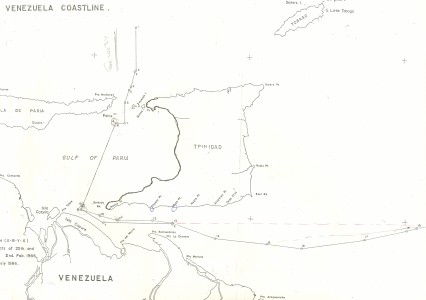|
The 1990 Accord Replaces the 1942 Paria Treaty
Posted: Wednesday, April 28, 2004
By Stephen Kangal

Columnist UWI Professor Hamid Ghany writing recently indicated that the 1990 TT/ Venezuela Delimitation Treaty revised the 1942 Gulf of Paria Treaty concluded on 26 February 1942 between Great Britain (HMG) and the Republic of Venezuela. This is not quite correct. The 1990 Treaty replaced and rendered null and void by succession the 1942 Treaty. They are in fact and in law two separate and independent international legal instruments with the former now in force. The latter by agreement"…cease(d) to have effect between the Contracting Parties .." when Article XII of the 1990 Treaty entered into force and effect on ratification, 23 July 1991.
The attached chart shows the extent to which the new agreed 1990 boundary in the Gulf of Paria and adjacent areas (Serpent's Mouth) deviated northwards from the 1942 BY-YX boundaries giving up 40.8 square miles of space formerly included in T&T and shown within the elongated triangle. This area was annexed by the HMG and formed part of the territory of T&T as discussed below.
Fundamental reform of the Law of the Sea commencing in 1973, the coming into force of the 1982 Montego UNCLOS as well as the consistent and uniform practice (customary law) that the UN Conference (1967-1982) spawned world-wide relating to increasing coastal state competence, as well as the confusing jurisdictional anomalies prevailing in the marine areas of the Gulf of Paria precipitated and drove the conclusion of the 1990 bilateral accord.
While the said 1942 Treaty was applicable to the submarine marines located seawards of the then 3-mile territorial sea in the Gulf of Paria and the Columbus Channel extending to Roja Point on the South coast of T&T, the 1990 Treaty is in fact a comprehensive accord delimiting all recognised maritime zones i.e. the archipelagic waters, the territorial sea (TS), the Exclusive Economic Zone (EEZ) and the regime of the Continental Shelf beginning at the seaward limits of the EEZ.
Having established irrefutably that there is no legal nexus between the two treaties it must however be appreciated that the 1942 Treaty boundary reflected the sea power differentials existing between Britain (HMG) and Venezuela in 1942. HMG knew of the hydrocarbon potential as pointed out by Professor Ghany. Hence HMG's maximum claim of the seabed without great concern for the fishing resources of the superjacent waters. The cession of the Patos Island to Venezuela constituted part of the trade -off or bargaining chip for a larger submarine allocation to Britain effected by the 1942 Treaty in the BY-YX sections beginning at The Serpent's Mouth eastwards. The recognition worldwide of a 12-mile territorial sea that was also promulgated by both T&T (1969) and Venezuela (1956) produced areas of anomalies causing problems to fishermen and oil- rig workers.
In some parts of the Gulf after 1969 (when T&T declared a 12-mile TS) on both sides of the AB boundary the waters came under the jurisdiction of Venezuela (via its 1956 Law) but the submarine areas below this water column were under the jurisdiction of T&T under the 1942 Treaty and vice versa. That was a prescription for chaos and frequent arrests of fishermen and marine oil- rig workers. As a result of this confusing dual jurisdiction an oil worker assigned to a rig in some areas located east of the AB boundary, if he threw a line to fish violated the sovereignty of Venezuela but was legitimately drilling for oil on the seabed on behalf of T&T.
HMG on 6th August 1942 annexed its share of the submarine areas of the Gulf located eastwards of the AB Boundary by the Submarine Areas of the Gulf of Paria (Annexation) Order 1942 and "attached … to the Colony of Trinidad and Tobago for administrative purposes:" It is this that led Parliament erroneously to include in The Preliminary Section (1) of both the 1962 and 1976 Constitutions the submarine areas of the TS and CS as part of our territorial integrity. This error was alluded to by Independent Senator Anmolsingh-Mahabir in the Senate recently.
Notice must be taken of the fact that the 1990 Treaty used the original Gulf of Paria Treaty- AB line to fix points 8 and 9 but shifted the lines BY-YX northwards in order to determine and establish the bilateral boundaries of the 12 mile-TS in this area (Points 10,11 12 and 13). In this process T&T surrendered 40.8 square miles of ocean space by the shift although this area was in fact annexed by the above-mentioned 1942 Order to form part of our territorial sovereignty and ownership. That constituted the basis for the then PNM Opposition in 1991 to charge the NAR Robinson Administration with ceding territory to Venezuela without obtaining the requisite Parliamentary approval.
In fact the current PNM Manning Administration finds itself embarrassingly cornered in the horns of a dilemma by having to adopt an official government position related to the defence of the 1990 Treaty that violently undermines and calls into question not only the credibility factor but also consistency in policy as well as the penchant for deriving political mileage at the expense of the national good and the patrimony.
It beckons us to wonder whether politics have and always have been the juggling art of deception instead of the traditional art of compromise or whether the majority easily be deceived by a few con artists parading under the façade, guise and mask of good governance.
 Send page by E-Mail Send page by E-Mail
|
|